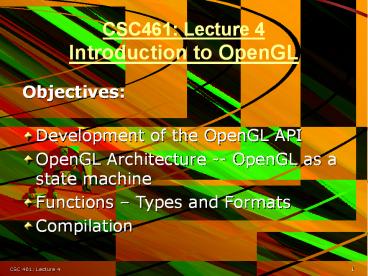CSC461: Lecture 4 Introduction to OpenGL - PowerPoint PPT Presentation
Title:
CSC461: Lecture 4 Introduction to OpenGL
Description:
Development of the OpenGL API. OpenGL Architecture -- OpenGL as a state machine ... Cygwin (linux under Windows) Can use gcc and similar makefile to linux ... – PowerPoint PPT presentation
Number of Views:49
Avg rating:3.0/5.0
Title: CSC461: Lecture 4 Introduction to OpenGL
1
CSC461 Lecture 4Introduction to OpenGL
- Objectives
- Development of the OpenGL API
- OpenGL Architecture -- OpenGL as a state machine
- Functions Types and Formats
- Compilation
2
Early History of APIs
- IFIPS (1973) formed two committees to come up
with a standard graphics API - Graphical Kernel System (GKS)
- 2D but contained good workstation model
- Core
- Both 2D and 3D
- GKS adopted as IS0 and later ANSI standard
(1980s) - GKS not easily extended to 3D (GKS-3D)
- Far behind hardware development
3
PHIGS and X
- Programmers Hierarchical Graphics System (PHIGS)
- Arose from CAD community
- Database model with retained graphics
(structures) - X Window System
- DEC/MIT effort
- Client-server architecture with graphics
- PEX combined the two
- Not easy to use (all the defects of each)
4
SGI and GL
- Silicon Graphics (SGI) revolutionized the
graphics workstation by implementing the pipeline
in hardware (1982) - To use the system, application programmers used a
library called GL - With GL, it was relatively simple to program
three dimensional interactive applications
5
OpenGL
- The success of GL lead to OpenGL (1992), a
platform-independent API that was - Easy to use
- Close enough to the hardware to get excellent
performance - Focus on rendering
- Omitted windowing and input to avoid window
system dependencies
6
OpenGL Evolution
- Controlled by an Architectural Review Board (ARB)
- Members include SGI, Microsoft, Nvidia, HP,
3DLabs,IBM,. - Relatively stable (present version 1.4)
- Evolution reflects new hardware capabilities
- 3D texture mapping and texture objects
- Vertex programs
- Allows for platform specific features through
extensions
7
OpenGL Libraries
- OpenGL core library
- OpenGL32 on Windows
- GL on most unix/linux systems
- OpenGL Utility Library (GLU)
- Provides functionality in OpenGL core but avoids
having to rewrite code - Links with window system
- GLX for X window systems
- WGL for Widows
- AGL for Macintosh
8
GLUT
- OpenGL Utility Toolkit (GLUT)
- Provides functionality common to all window
systems - Open a window
- Get input from mouse and keyboard
- Menus
- Event-driven
- Code is portable but GLUT lacks the functionality
of a good toolkit for a specific platform - Slide bars
9
Software Organization
10
OpenGL Architecture
11
Programmers View
- Three components
- Specify a set of objects to render
- Describe properties of these objects
- Define how these objects should be viewed
12
OpenGL Functions
- Primitives
- Points
- Line Segments
- Polygons
- Attributes
- Transformations
- Viewing
- Modeling -- Windowing
- Control
- Input (GLUT)
13
OpenGL State
- OpenGL is a state machine
OpenGL Pipeline
14
OpenGL Function Types
- OpenGL functions are of two types
- Primitive generating
- Can cause output if primitive is visible
- How vertices are processes and appearance of
primitive are controlled by the state - State changing
- Transformation functions
- Attribute functions
- Colors, viewing conditions, material properties,
lighting, shading, etc.
15
Lack of Object Orientation
- OpenGL is not object oriented so that there are
multiple functions for a given logical function,
e.g. - glVertex3f,
- glVertex2i,
- glVertex3dv,..
- Underlying storage mode is the same
- Easy to create overloaded functions in C but
issue is efficiency
16
OpenGL function format
17
OpenGL defines
- Most constants are defined in the include files
gl.h, glu.h and glut.h - Note include ltglut.hgt should automatically
include the others - Examples
- glBegin(GL_PLOYGON)
- glClear(GL_COLOR_BUFFER_BIT)
- include files also define OpenGL data types
Glfloat, Gldouble,.
18
Notes on compilation
- Unix/linux
- Include files usually in /include/GL
- Compile with lglut lglu lgl loader flags
- May have to add L flag for X libraries
- Mesa implementation included with most linux
distributions - Check web for latest versions of Mesa and glut
- See website and ftp for your computer
19
Compiler
- Example
- Unix
- cc myapp.c o myapp lglut lglu lgl lX11 -lm
- Linux
- cc myapp.c o myapp lglut lglu lgl
l/usr/X11R6/lib -lm
20
Compilation on Windows
- Visual C
- Get glut.h, glut32.lib and glut32.dll from web in
the system folder - Create a console application
- Add opengl32.lib, glut32.lib to project settings
(under link tab) - Lib files should be ..\VC\lib
- Include files should be ..\VC\include\GL
- Borland C similar
- Cygwin (linux under Windows)
- Can use gcc and similar makefile to linux
- Use lopengl32 lglu32 lglut32 flags






























